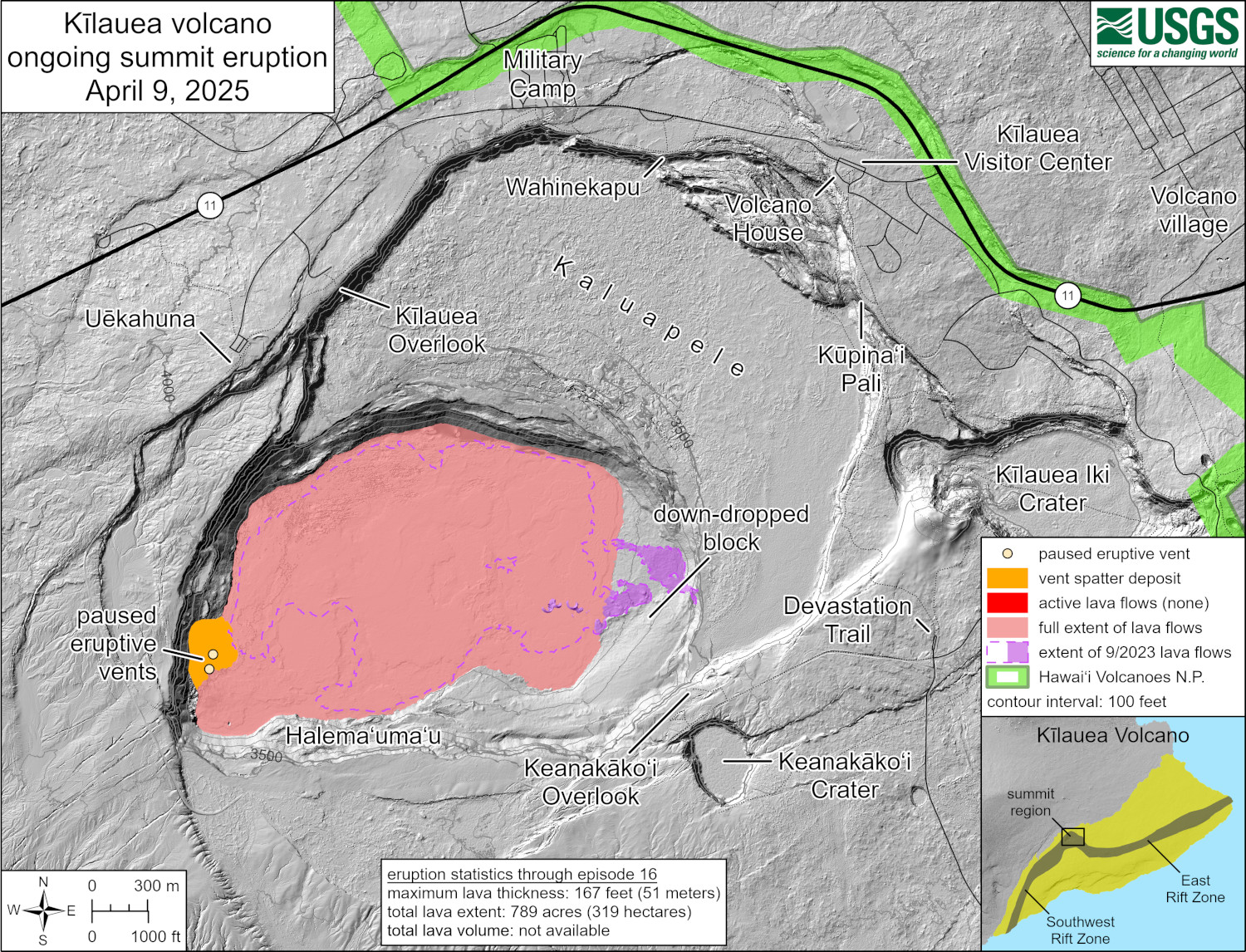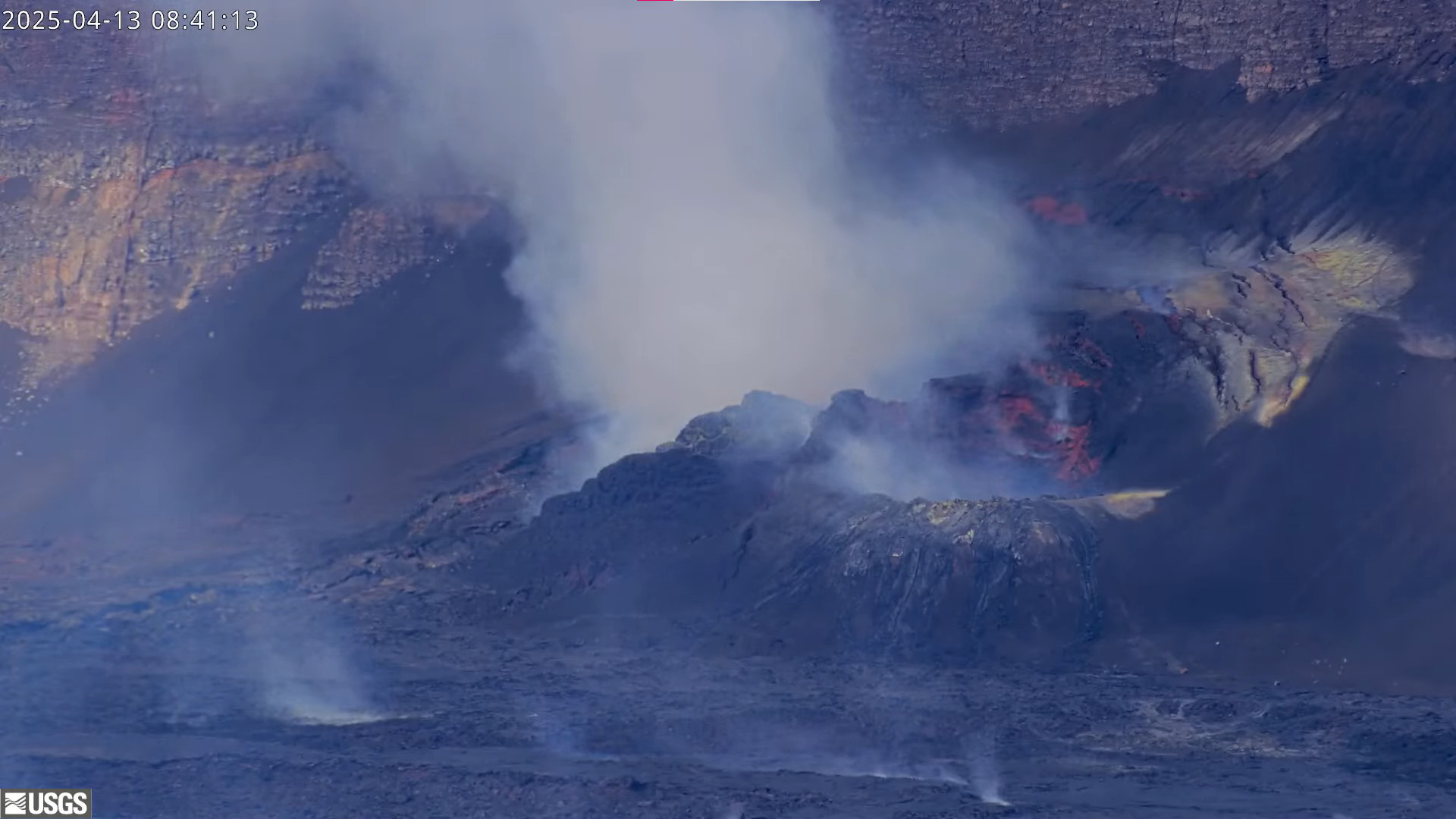(BIVN) – The ongoing eruption at the summit of Kīlauea remains paused, and scientists say that “if the eruptive activity reverts to pre-episode 17 behavior, data indicate that episode 18 is likely to begin in the next 2-4 days.”
Episode 17 began earlier than forecasted and exhibited characteristics that differed from other recent episodes. Episode 17 also did not include a high lava fountaining phase.
The USGS Alert level for Kīlauea is at WATCH. All eruptive activity remains within Hawai’i Volcanoes National Park. No significant activity has been noted along Kīlauea’s East Rift Zone or Southwest Rift Zone.

USGS: “This reference map depicts the Kīlauea summit eruption within Halema‘uma‘u crater that began on December 23, 2024. As of this posting on April 9, the eruption has had seventeen episodes, with the most recent concluding earlier this morning. However, most of the map data included here were collected during a Hawaiian Volcano Observatory helicopter overflight on April 2, immediately following episode 16; for this reason, the provided statistics only reflect the first sixteen episodes of the eruption. Additionally, the collected data were insufficient to calculate the total lava volume for the eruption at that time.”
From the USGS Hawaiian Volcano observatory Report on Saturday:
Summit Observations:
The south vent had a faint glow for most of the night with short periods of moderate glow. Degassing is currently only occurring from the south vent.
Low lava fountaining began the night of April 7 at the south vent around 10:15 p.m. HST and started to produce a small lava flow that spread across the crater floor. During episode 17 sustained fountains ranged from about 50 feet (15 meters) high to bursts up to 200 feet (60 meters) from primarily the south vent with a short period of minor fountaining at the north vent. At 9:45 a.m. HST on April 9, fountaining from the south vent stopped, marking the end of episode 17. During this episode, lava flows covered over 40-50% of the floor of Halemaʻumaʻu within the southern part of Kaluapele (Kīlauea caldera). Additional details about the eruption were posted earlier in the April 8 Status Report, the April 8 Daily Update for Kīlauea, the April 9 Daily Update for Kīlauea, and the April 9 Status Report.
The UWD and SDH tiltmeters show a distinct change in tilt from deflationary to inflationary trending that is coincident with the end of episode 17. As of this morning, UWD has measured a little less than 6.5 microradians of inflationary tilt since 9:45 a.m. HST April 9. Seismic tremor rapidly dropped in intensity on April 9 at 9:45 a.m. HST when episode 17 ended and continues at low levels.
Volcanic gas emissions remain elevated and at heightened levels due to lava fountaining. The last sulfur dioxide (SO2) emission rate measured on April 10 was approximately 1,200 tonnes per day. Typical levels of Sulfur dioxide (SO2) emission have been about 1,000 tonnes per day during previous pauses. This morning, the plume is being carried towards the southwest.
Strands of volcanic glass known as Pele’s Hair from previous episodes are still present throughout the summit area of Hawai’i Volcanoes National Park and surrounding communities and can be remobilized by wind if present.
Analysis:
The current eruption has been characterized by episodic fountaining not seen in any of the other Halemaʻumaʻu eruptions since 2020. Fountains and lava flows have erupted from two vents that we refer to as the north vent and south vent. Each of the previous 16 fountaining episodes lasted from a few hours to over a week and has been accompanied by strong deflation of the summit region. Pauses between the fountaining episodes have been marked by an immediate change from deflation to inflation as the magma chamber recharges and repressurizes.
Analysis of inflationary tilt patterns prior to the onset of each fountaining episode allows a time window of probability for the onset of new episodes to be estimated. These are calculated using both minimum inflation necessary to start a new eruption and the rate of inflation fit to data derived from past eruptive episodes. The onset of episode 17 occurred earlier than forecasted, as the fountaining began prior to the tilt rebounding to the expected threshold that had been previously associated with episode onsets. If the eruption returns to pre-episode 17 inflation behavior, data suggest episode 18 will likely begin between Monday and Wednesday of next week, 2-4 days from now. This window may be adjusted if inflation rates change significantly.


by Big Island Video News8:51 am
on at
STORY SUMMARY
HAWAIʻI VOLCANOES NATIONAL PARK - Scientists say the next eruptive episode, Episode 18, is likely to begin in the next few days.